Crafting homemade gnocchi and fresh pasta might seem daunting at first glance, but the truth is, creating these Italian delicacies from scratch is surprisingly straightforward. With just a handful of basic ingredients and simple techniques, anyone can master the art of making delicious, pillowy gnocchi right in their own kitchen. This comprehensive guide will walk you through every step of preparing exquisite Homemade Potato Herb Gnocchi, ensuring you can savor this comforting dish whenever your heart desires.
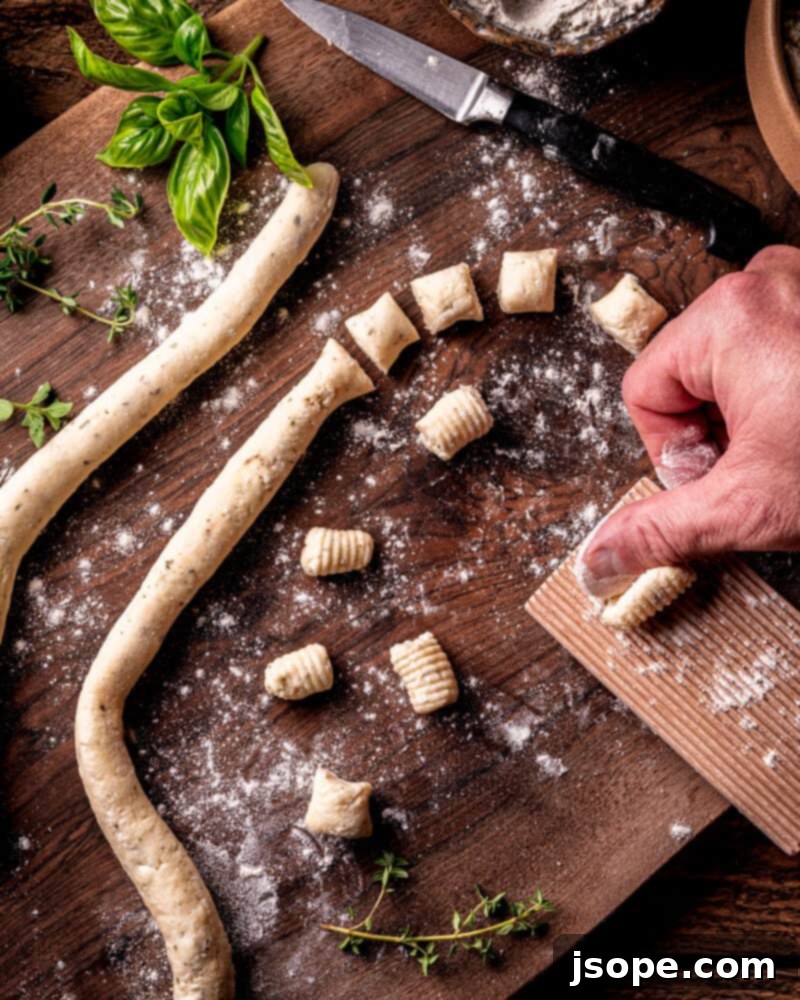
Understanding Gnocchi: A Culinary Exploration
Gnocchi, a beloved staple of Italian cuisine, appears in a fascinating array of forms, each distinguished by its unique key ingredients, shapes, sizes, and even cooking or serving methods. At its heart, gnocchi is a small, soft dumpling, traditionally made with a base of potato, a minimal amount of flour, and eggs or egg yolks. Our featured Italian gnocchi recipe adheres to this classic description, yielding the tender, melt-in-your-mouth texture that gnocchi enthusiasts adore.
However, the world of gnocchi extends far beyond this common understanding, encompassing a rich tapestry of regional variations across Italy. These diverse interpretations can often lead to confusion and lively debates among purists about what truly constitutes “authentic” Italian gnocchi. To navigate this delightful complexity, let’s explore the fundamental characteristics that most people associate with the term ‘gnocchi,’ along with its fascinating regional cousins.
Is Gnocchi a Type of Pasta? Clarifying a Common Misconception
One of the most frequently asked questions about gnocchi is whether it falls under the umbrella of pasta. The answer, surprisingly, isn’t a simple yes or no. For the purpose of this authentic gnocchi recipe, and what most people envision when they hear “gnocchi,” the answer is definitively NO, it is not pasta. The potato-based gnocchi we discuss here are, in culinary terms, a form of dumpling.
While some regional gnocchi varieties, particularly those made predominantly from semolina flour, do blur the lines and could arguably be classified as pasta, the most common types – those crafted from potatoes or ricotta cheese – are technically dumplings. They differ from traditional pasta in their dough composition, preparation, and characteristic soft, pillowy texture. Nevertheless, if you casually refer to gnocchi as pasta, rest assured that few will be offended or feel the need to correct you. It’s a widely accepted colloquialism, and many recipe blogs, including ours, often feature gnocchi recipes alongside pasta dishes for convenience, recognizing their shared place in Italian meal traditions.
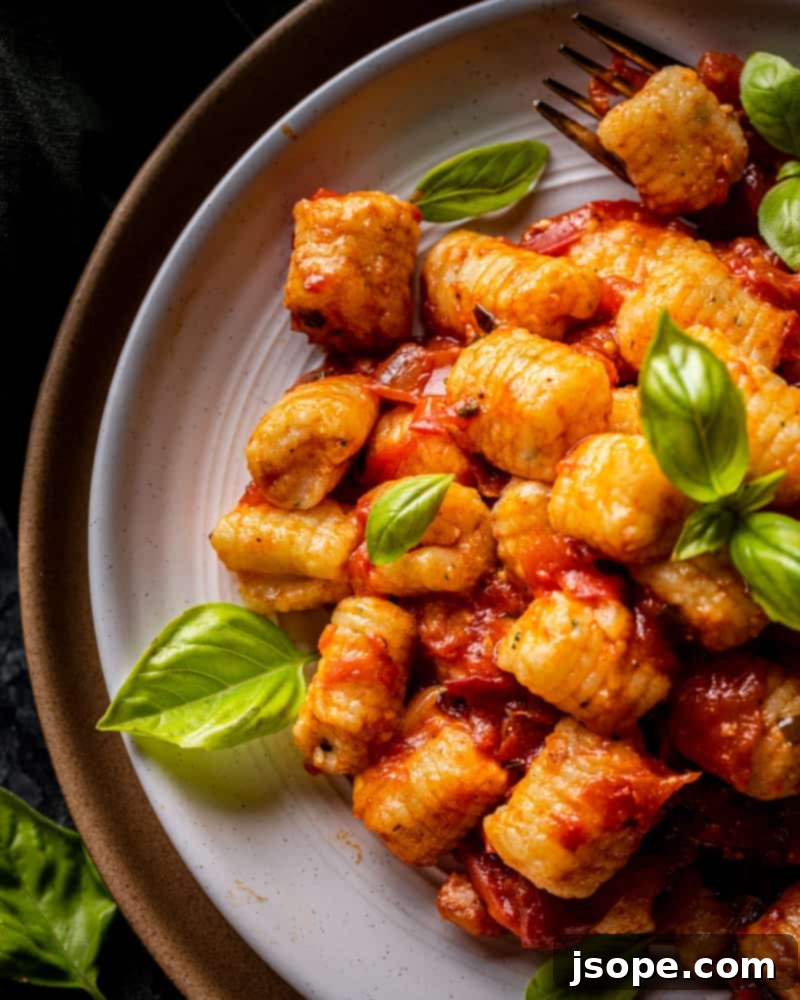
Discovering Italy’s Diverse Gnocchi by Region
Italy, a country celebrated for its regional culinary distinctions, boasts an astonishing array of gnocchi variations. When considering the most common potato or ricotta-based gnocchi, a general pattern emerges: potatoes tend to dominate gnocchi recipes in Southern Italy, while ricotta is a more prevalent base in the Northern regions. Regardless of the base ingredient, one consistent quality unites all properly made gnocchi: they are consistently light, fluffy, pillowy, and utterly delicious!
To truly appreciate the breadth of gnocchi, let’s delve into some additional regional types that extend beyond the familiar potato or ricotta varieties:
- Malfatti: Hailing from Lombardy in Northern Italy, Malfatti (meaning “badly made” or “misshapen”) are large, hearty ricotta-based dumplings. Often enriched with spinach and fresh herbs, they typically feature a rustic, round shape and are traditionally served with a simple yet flavorful tomato sauce.
- Gnudi: These Tuscan “naked” dumplings, smaller than Malfatti, are also ricotta-based and round. The name “gnudi” perfectly describes them, as they resemble the flavorful filling of a ravioli, presented without the enclosing pasta shell. Their delicate texture and rich flavor make them a sought-after specialty.
- Ndunderi: Originating from the picturesque Amalfi Coast, south of Naples, Ndunderi are larger than traditional gnocchi and are unique for their combination of ricotta and pecorino (sheep’s milk cheese). This ancient recipe, with roots stretching back centuries, typically pairs Ndunderi with robust tomato sauces or savory sausage ragùs, reflecting the rustic flavors of the region.
- Malloreddus (Gnocchetti Sardi): A specialty from Sardinia, these are distinctly different as they are indeed a type of pasta. Primarily made from semolina flour, not potato or ricotta, Malloreddus are small, ridged shells that are often served with a rich sausage and fennel ragù. They bear a close resemblance to cavatelli, another beloved pasta from Apulia and other southern Italian regions.
- Gnocchi alla Romana: This Roman comfort food stands apart from the rest, as it is baked rather than boiled. Made with semolina, milk, egg yolks, and cheese, Gnocchi alla Romana results in a dish of golden, creamy discs, a delightful culinary experience that, while called “gnocchi,” offers a completely different texture and preparation method than the more traditional, boiled varieties.
Beyond Italy’s borders, countless other versions of gnocchi exist, each with its own distinct flavor profile, culinary traditions, and passionate following. Exploring these variations is a wonderful journey for any food enthusiast.
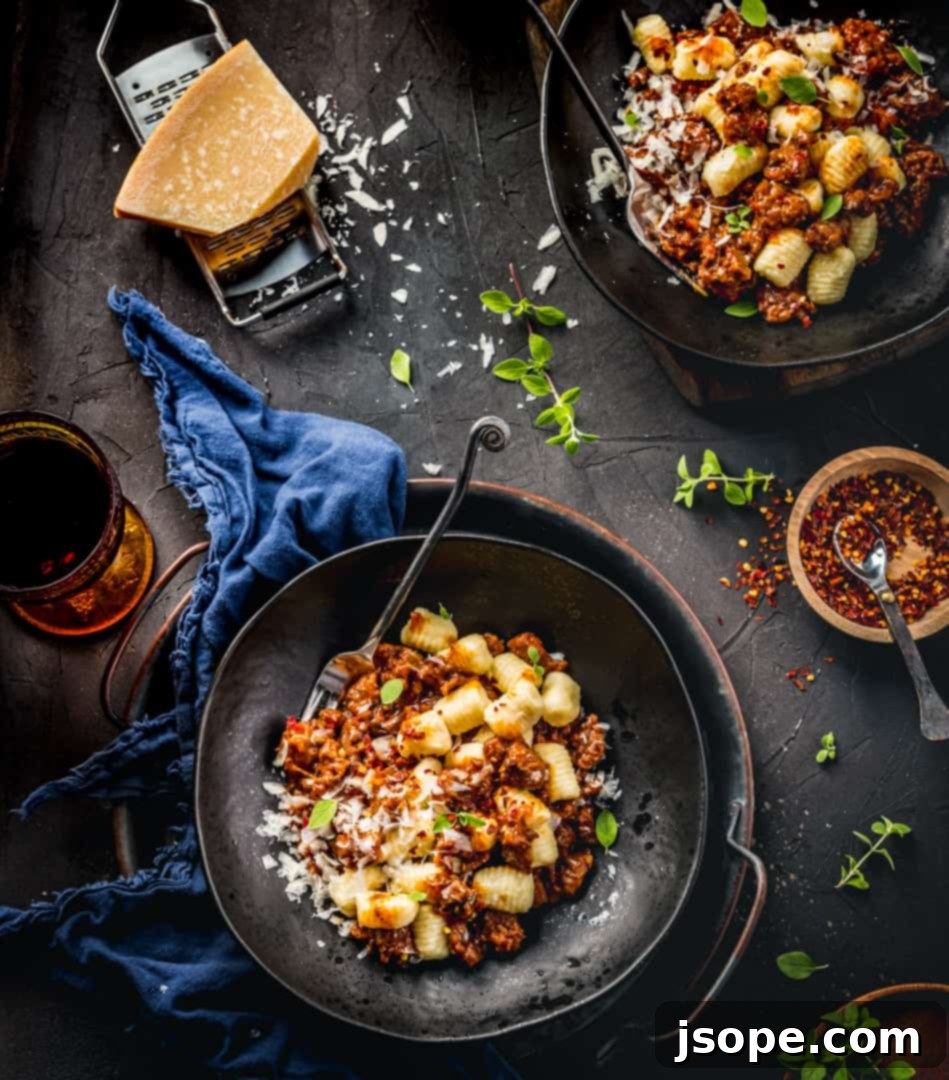
Essential Ingredients for Perfect Potato Herb Gnocchi
The magic of delicious gnocchi lies in its simplicity. With just a few high-quality ingredients, you can create a dish that tastes complex and satisfying. Here’s a closer look at what you’ll need for our potato herb gnocchi recipe:
- Potatoes
- All-Purpose Flour (or Tipo 00)
- Eggs
- Kosher Salt
- Fresh or Dried Herbs
- Semolina Flour (for dusting)
Selecting and Preparing the Right Potatoes
As the star of authentic potato gnocchi, the choice and preparation of potatoes are paramount. While many types of potatoes can yield excellent results, the overarching goal is to minimize moisture content in the cooked potato. Excess water will force you to add more flour, leading to dense, heavy gnocchi instead of the desired light, airy texture.
We recommend boiling potatoes whole and unpeeled. The skin acts as a natural barrier, preventing the potato flesh from absorbing too much water during cooking. Once fork-tender, remove them from the water promptly. If you suspect your potatoes have become waterlogged for any reason, a simple trick is to cut or break them open slightly to expose the flesh, then bake them in a 300°F (150°C) oven for about 30 minutes. This gentle heat will evaporate excess moisture, resulting in drier, more concentrated potato flavor.
For the best outcome, opt for starchy or medium-starch varieties. Red-skinned or Yukon Gold potatoes are excellent choices, offering a good balance of starch and moisture. Russet “baking” potatoes are also fantastic, known for their floury texture when cooked, which is ideal for gnocchi.
The Art of Using Just Enough Flour
Flour serves as the binder in gnocchi dough, holding everything together without making the final product heavy or dense. This is a crucial balancing act: too little flour and the gnocchi won’t hold their shape; too much, and you end up with “gut-bombs”—chewy, leaden dumplings that are the antithesis of perfect gnocchi. If you’ve ever encountered a dense gnocchi, it was likely due to an excess of flour and an overworked dough.
We typically use Tipo 00 flour or standard all-purpose flour for our gnocchi. Tipo 00 is a finely milled Italian flour that creates a very tender dough, but all-purpose flour works beautifully too. The key is to add just enough flour until the dough is cohesive and manageable, rather than strictly adhering to a measurement. The exact amount can vary based on your potato’s moisture content.
The Role of Eggs in Gnocchi
Eggs are another essential binder in traditional gnocchi recipes. Some recipes call for whole eggs, while others prefer just the yolks for richness. For our recipe, a single fresh, large whole egg provides the perfect balance. The egg white helps to lighten the gnocchi’s texture, contributing to that desired airy quality, while the yolk adds a subtle richness and a beautiful golden hue to the dough. It binds the ingredients without making the gnocchi rubbery.
Enhancing Flavor with Fresh or Dried Herbs
Here’s where you can truly unleash your creativity! Infusing your homemade gnocchi with herbs adds a wonderful aromatic dimension. Almost any herb, whether fresh or dried, can elevate your gnocchi. We often opt for dried herbs due to their convenience and consistent flavor delivery, though there are exceptions.
Fresh rosemary, in our experience, typically outperforms its dried counterpart, imparting a more vibrant, piney aroma. Other fantastic options include basil, thyme, oregano, and marjoram. Don’t be afraid to experiment with combinations! Beyond herbs, consider adding a pinch of ground black pepper, a touch of red pepper flakes for a subtle kick, or even some bright citrus zest (lemon or orange) to introduce a fresh, unexpected note. The possibilities are endless, and your favorite combination will likely yield delicious results.
The Secret to Non-Sticky Gnocchi: Semolina Flour for Dusting
As you form your delicate gnocchi pillows, preventing them from sticking to your work surface, hands, or the baking sheet is crucial. This is where semolina flour shines. We generously dust our baking sheets with semolina before placing the freshly made gnocchi on them. This specialized flour is a game-changer for maintaining their individual shape.
Semolina flour, milled from durum wheat, has a coarser texture than all-purpose flour. This rougher consistency creates an excellent non-stick barrier, far superior to what common all-purpose flour can offer. It also contributes a subtle chewiness and golden color to the gnocchi’s exterior once cooked.

Essential & Optional Equipment for Homemade Gnocchi
One of the beauties of making gnocchi at home is that you don’t necessarily need a plethora of specialized gadgets. While some tools can certainly make the process easier and more consistent, you can absolutely achieve fantastic results with basic kitchen essentials. Let’s break down what’s necessary and what’s recommended:
Equipment:
- Large Pot (for boiling potatoes and cooking gnocchi)
- Large Mixing Bowl
- Potato Ricer (optional, but highly recommended for the best texture)
- Gnocchi Board (optional, but traditional for creating ridges)
- Bench Scraper (optional, or a sharp knife)
- Spider Spatula / Slotted Spoon (for retrieving cooked gnocchi)
The Unmatched Benefit of a Potato Ricer
If you’re familiar with a garlic press, then you already grasp the fundamental concept behind a potato ricer. Essentially, it’s an oversized version designed to process cooked potatoes. This ingenious tool gently presses potatoes through small holes, creating light, airy strands that resemble rice. The key advantage of a ricer is that it processes the potato without overworking it or pulverizing the starch cells, which can otherwise lead to a dense, pasty, or gummy texture. By keeping the potato cells largely intact, a ricer ensures your gnocchi will be as light as a cloud.
While not strictly mandatory, we strongly advocate for using a ricer over a traditional potato masher, sieve, tamis, or even a fork. These alternative methods can sometimes require more effort to achieve a smooth consistency and increase the risk of overworking the potato, which is a common pitfall. However, don’t let the lack of a ricer deter you! You can still make delightful gnocchi by carefully mashing your potatoes thoroughly with a fork, ensuring no large lumps remain, and being mindful not to overwork the potatoes.
Can I Make Gnocchi Without a Gnocchi Board?
Absolutely! The gnocchi board, with its distinctive ridges, is a traditional tool designed to impart a textured surface onto each gnocchi. These grooves are more than just decorative; they serve a practical purpose, allowing the gnocchi to better “catch” and hold onto your delicious sauces. However, the absence of a gnocchi board is by no means a deal-breaker for homemade gnocchi.
In fact, centuries ago, gnocchi were shaped by rolling them against the inside of wicker baskets, demonstrating that the concept of adding texture predates the modern gnocchi board. Leaving your gnocchi as simple, smooth pillows is perfectly acceptable and yields a lovely result. If you wish to create ridges without a specialized board, a standard dinner fork is your best alternative. Gently roll each gnocchi piece over the tines of a fork, applying light pressure with your thumb or finger. This simple technique will create attractive grooves that will enhance both the appearance and sauce-holding capability of your gnocchi. You can refer to our recipe video (linked in the recipe card below) for a visual demonstration of how to use a gnocchi board effectively.
Avoiding the Common Pitfalls: How to Prevent Dense and Chewy Gnocchi
Achieving light, fluffy, and tender gnocchi is the ultimate goal, but a few common mistakes can unfortunately lead to a dense, chewy, and disappointing batch. Fortunately, these pitfalls are entirely avoidable with a little awareness and careful technique. Here are the three crucial points to remember:
- Do Not Over-Mash or Overwork the Potatoes: The first and perhaps most critical pitfall lies in the handling of the cooked potatoes. Potatoes contain starch, and when over-mashed or vigorously worked, this starch can develop into a gummy, sticky, and dense mixture. This is precisely why a potato ricer is so highly recommended; it processes the potatoes gently, minimizing starch activation. If you’re using a traditional masher, a fork, or a tamis, aim to mash the potatoes just enough to achieve a uniform, lump-free consistency. Stop as soon as they are smooth, and resist the urge to continue mashing or stirring beyond that point. Gentle handling is key to preserving their light texture.
- Be Mindful of Too Much Flour: The second common mistake is incorporating an excessive amount of flour into your gnocchi dough. While flour is necessary for structure, too much will inevitably lead to heavy, dense, and unpleasant gnocchi. This problem often arises when the potatoes themselves are too moist or waterlogged, requiring more flour to absorb the excess liquid and bring the dough together. To prevent this, always start your whole, unpeeled potatoes in a large pot of cold water and boil them just until fork-tender. If you find your cooked potatoes are still too wet, don’t despair! Cut them open or break them into pieces, spread them on a baking sheet, and pop them into a 300°F (150°C) oven for about 20-30 minutes. This will help evaporate excess moisture, allowing you to use less flour and achieve a lighter dough.
- Never Overwork the Gnocchi Dough: Finally, and just as important as potato preparation, is the handling of the gnocchi dough itself. Unlike pasta dough, which benefits from extensive kneading to develop gluten and create elasticity, gnocchi dough should be worked as little as possible. Kneading it vigorously, as you would bread or traditional pasta, will develop too much gluten. This gluten development results in tough, rubbery, and disappointingly chewy gnocchi instead of the desired tender, airy texture. Your goal is simply to combine the ingredients until they form a cohesive mass – nothing more. Mix until just incorporated, then stop. Embracing this gentle approach will ensure every batch of fluffy gnocchi you make is unforgettable.

Freezing Raw Gnocchi for Future Enjoyment
One of the many conveniences of making homemade gnocchi is its freezer-friendly nature. You can absolutely freeze raw gnocchi, allowing you to prepare a large batch and enjoy freshly cooked gnocchi whenever the craving strikes. To freeze them properly, arrange the freshly formed gnocchi in a single layer on a parchment-lined baking sheet, ensuring they do not touch each other. Place the baking sheet in the freezer for a full hour, or until the gnocchi are solid. This prevents them from sticking together once bagged.
Once frozen solid, transfer the gnocchi to a freezer-safe zip-top bag or airtight container. They can be stored in the freezer for up to 2-3 months. When you’re ready to cook, simply drop the frozen gnocchi directly into boiling water—no need to thaw! They may take approximately 1-2 minutes longer to cook than fresh gnocchi, but the texture and flavor will be just as delightful as if they were made on the same day. This method is far superior to freezing cooked gnocchi, which can often result in a mushy texture upon reheating.
Pre-Cooking Preparation: The Freezer Trick
Even if you plan to cook your gnocchi on the same day you make them, a brief stint in the freezer can significantly improve their final texture and make handling easier. After forming your gnocchi and arranging them in a single layer on a semolina-dusted baking sheet, place them in the freezer for about 30 minutes. This quick chill helps to firm up the dough, allowing the gnocchi to maintain their delicate shape better during cooking. It also makes them more resilient when transferring them from the tray to the pot of boiling water, preventing them from sticking or breaking apart. This simple step is a chef’s secret for more robust and perfectly cooked gnocchi.
Top Tips for Cooking Gnocchi to Perfection
Cooking gnocchi might seem simple – just boil water and drop them in – but a few expert tips can make all the difference between good gnocchi and truly spectacular, pillowy results:
- Start with a Large Pot of Water: Always use a generously sized pot filled with plenty of water. Crowding gnocchi in a small pot with insufficient water will cause the water temperature to drop too quickly, leading to uneven cooking and, most importantly, the gnocchi sticking together in a gummy mess. Ample space allows them to cook freely and evenly.
- Heavily Salt the Water: Just like pasta, gnocchi needs to be seasoned from within. Add a substantial amount of salt to your boiling water – think seawater salinity, roughly 2 tablespoons for every 6-8 quarts (liters) of water. This not only infuses the gnocchi with flavor but also helps prevent them from sticking to each other and the bottom of the pot by increasing the water’s boiling point and creating a less sticky surface.
- Wait for a Rolling Boil & Create a Whirlpool: Ensure your heavily salted water is at a vigorous, rolling boil before adding the gnocchi. A strong boil helps cook them quickly and efficiently. As you add the gnocchi, take a large spoon or spatula and give the water a good stir to create a gentle whirlpool. This swirling motion prevents the gnocchi from sinking directly to the bottom and clumping together, ensuring they disperse and cook individually.
- Gnocchi are Done Once They Float: The most reliable indicator that your gnocchi are cooked is when they float to the surface of the boiling water. This usually takes only 2-3 minutes. Once they rise, give them another 30 seconds to a minute to ensure they are cooked through. Do not overcook! Promptly remove them from the water using a spider spatula, slotted spoon, or a fine-mesh sieve that fits easily into your pot. Transfer them directly to your prepared sauce to toss and serve immediately.
Delicious Sauce Pairings for Your Homemade Gnocchi
The delicate, tender texture of gnocchi makes it an incredibly versatile canvas for a wide array of sauces. From rich and creamy to light and vibrant, here are some perfect pairings to elevate your potato gnocchi dinner:
Cream Sauces
Cream sauces are always a fantastic choice with gnocchi, providing a luxurious and comforting experience. The tender dumplings readily absorb the rich flavors. Some of our top recommendations include a hearty Sausage Mushroom Cream Sauce for a robust meal, or an elegant Parmesan Sage Cream Sauce that perfectly balances savory and herbaceous notes. A simple Gorgonzola cream sauce also pairs beautifully with the earthy potato base.
Pesto Sauces
For a quick, fresh, and intensely flavorful option, pesto sauces are unbeatable with gnocchi. Their vibrant flavors cling wonderfully to the soft dumplings. Experiment with our smooth and aromatic Creamy Basil Pesto, or try something a little different with a smoky and sweet Roasted Red Pepper Pesto. A classic Genovese pesto is always a winner too.
Tomato Sauces
Many, including us, consider a zesty tomato sauce to be the ultimate pairing for gnocchi. The bright acidity of tomatoes cuts through the richness of the gnocchi, creating a harmonious balance. For a unique twist, try our sweet and vibrant Yellow Tomato Sauce. Alternatively, a classic, slow-simmered Marinara Sauce from Scratch provides timeless comfort. For a heartier option, a rich Bolognese or a simple fresh cherry tomato sauce with basil works wonders.
Butter Sauces
A simple, elegant butter sauce highlights the delicate flavor of the gnocchi itself. The quintessential pairing is a nutty brown butter sage sauce, often finished with a generous dusting of Parmesan cheese. For a lighter, brighter alternative, consider a zesty White Wine Lemon Butter Sauce. Or, if you crave a bit of heat, our Calabrian Chili Butter Sauce adds a fiery, aromatic kick that’s truly addictive.
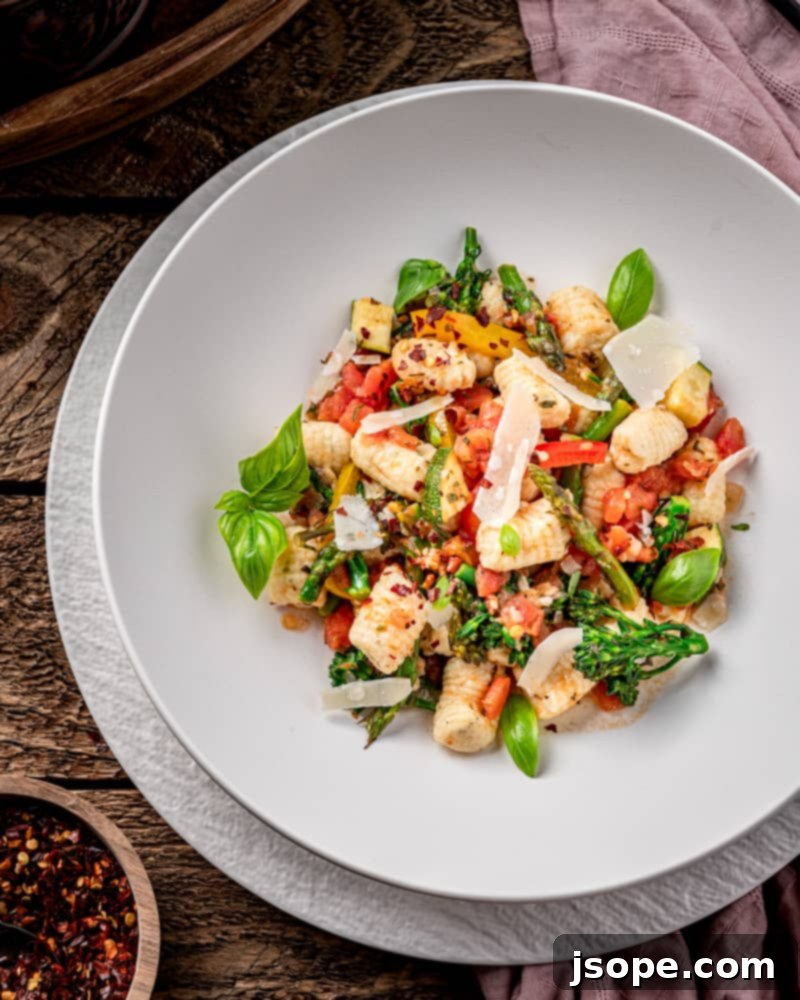
Storing and Reheating Cooked Gnocchi
If you find yourself with leftover cooked gnocchi, proper storage will ensure you can enjoy them again without compromising quality. Once your gnocchi have cooled to room temperature, transfer them to an airtight container and refrigerate for up to 5 days. To reheat, avoid the microwave, as it can make them mushy. Instead, gently warm them in a skillet over low to medium-low heat with a little butter, olive oil, or a splash of your chosen sauce. Stir them occasionally until they are warmed through and regain their soft texture. This slow reheating method prevents them from becoming rubbery or losing their tender consistency.
Explore More Delicious Gnocchi Recipes with Mangiamo!
If this guide has sparked your passion for gnocchi, you’re in luck! In early 2022, we proudly released our very first cookbook, Mangiamo! This culinary treasure features 60 exquisite Italian recipes, including three distinct types of gnocchi and a delightful variety of accompanying sauces. Discover new favorites and expand your Italian cooking repertoire:
- Potato Thyme Gnocchi with Gorgonzola Cream Sauce
- Sweet Potato Gnocchi with Brown Butter Rosemary Sauce
- Ricotta Gnocchi Primavera
- Ricotta Gnocchi with Sausage Sauce
While technically possible, we strongly advise against freezing cooked gnocchi. Reheating cooked gnocchi that has been frozen often results in a mushy, undesirable texture. For the best results, it is far better to freeze raw, uncooked gnocchi (after shaping them into little pillows) and then cook them directly from frozen when you’re ready to enjoy them. This preserves their delicate texture and ensures a fresh-tasting meal.
Gnocchi made with ricotta cheese instead of potato are commonly referred to as ricotta gnocchi. These are often celebrated for being lighter and less dense than their potato-based counterparts. Another well-known name for these delightful ricotta dumplings, particularly in Tuscany, is “gnudi,” which literally means “naked.” Gnudi typically contain significantly less flour and closely resemble the flavorful filling of ravioli, but without the pasta casing, offering a truly delicate and melt-in-your-mouth experience.
Enjoy Your Homemade Gnocchi!
We sincerely hope this detailed guide has empowered you to create incredible Homemade Potato Herb Gnocchi. There’s immense satisfaction in crafting such a delicious dish from simple ingredients. If you try this herbed gnocchi recipe, please share your experience in the comments below! We’d love to hear how it turned out. And if you absolutely loved this recipe, consider giving it a 5-star rating, clicking the heart icon, and sharing your beautiful final dish on Instagram by tagging @cooking_with_wine! Buon appetito!
📖 Recipe: Homemade Potato Herb Gnocchi
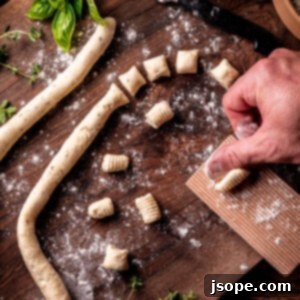
How to Make Homemade Potato Herb Gnocchi
Pin Recipe
Equipment
- 1 Large pot to cook gnocchi
Ingredients
- 1 ⅓ lbs (600g) red-skinned or Yukon gold potatoes of similar size
- 1 ¼ cups (156g) all purpose flour (plus more as needed)
- 1 large egg
- 2 teaspoon kosher salt
- 1 -2 tablespoon dried herbs of your choice
Instructions
Make the Gnocchi
- Place your whole, unpeeled potatoes in a large pot and cover them completely with cold water. Bring the water to a high boil, then reduce the heat to a simmer. Cook until the potatoes are very soft when pierced with a knife, offering little resistance (this typically takes 40 to 55 minutes, depending on potato size). Ensure the potatoes remain submerged, adding more water if necessary. Once tender, remove the potatoes and let them cool just enough to be handled comfortably.
- Line a baking sheet with parchment paper and lightly dust it evenly with semolina flour (or all-purpose flour if semolina is unavailable). Set this aside for later use.
- Carefully peel your cooled, cooked potatoes. Pass them through a potato ricer directly into a large mixing bowl. If you don’t have a ricer, mash them very thoroughly with a fork, or push them through a fine-mesh sieve (tamis) to ensure a smooth, lump-free consistency. Work quickly and avoid over-mashing.
- To the riced potatoes, add the measured flour, the large egg, kosher salt, and your chosen dried herbs. Using a sturdy serving spoon, a fork, or your hands, gently mix the ingredients together. Once the mixture starts to come together, turn it out onto a clean, lightly floured flat surface. Gently knead the dough just until it forms a cohesive ball. The key is to combine until *just* incorporated; do not overwork the dough like you would for bread or pasta, as this will develop too much gluten and result in dense gnocchi. The dough will be sticky, but it should be manageable.
- Using minimal flour to prevent sticking, divide the gnocchi dough into four equal sections. Take one section and gently roll it into a long “snake” or rope, approximately ¾ inch (2 cm) in diameter. Repeat with the remaining sections.
- Cut each rope into small, individual gnocchi pillows, about 1 inch (2.5 cm) long (adjust size as desired). For traditional ridges: gently roll each piece into a ball, then, using your thumb, gently push it down onto a gnocchi board to create grooves. Alternatively, roll the gnocchi over the tines of a fork. If you prefer smooth gnocchi, simply roll them between your palms to round off any sharp corners.
- Arrange the finished gnocchi in a single layer on your semolina-dusted baking sheet, ensuring they do not touch each other to prevent sticking. Place the baking sheet in the freezer for at least 30 minutes. This chilling period helps the gnocchi maintain their shape during cooking and makes them easier to handle.
Cook the Gnocchi
- Fill a large pot with plenty of water and bring it to a rolling boil. Once boiling vigorously, add a generous amount of salt (about ¼ cup per gallon of water) until it tastes like seawater. Stir the water vigorously to create a whirlpool, then gently drop the chilled gnocchi into the pot. Cook for 2-3 minutes, or until the gnocchi float to the top. Once floating, let them cook for another 30 seconds to 1 minute, then swiftly remove them with a slotted spoon or spider spatula. Transfer immediately to a serving bowl, toss with your preferred sauce, and serve hot!
